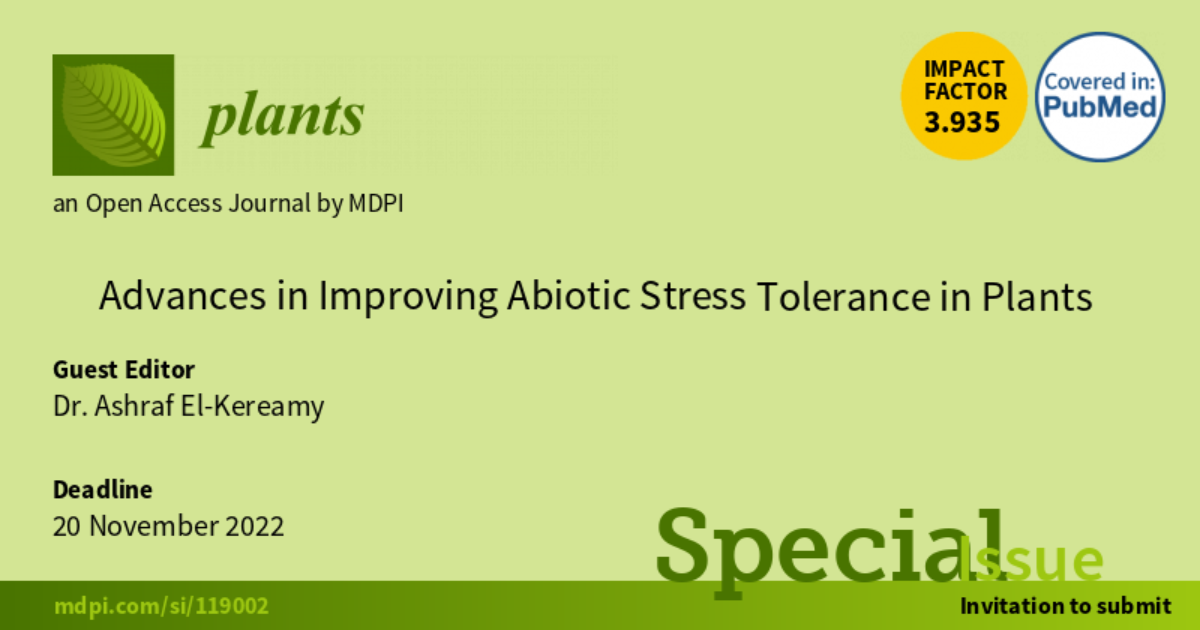- 4.1Impact Factor
- 7.6CiteScore
- 18 daysTime to First Decision
Advances in Improving Abiotic Stress Tolerance in Plants
This special issue belongs to the section “Plant Response to Abiotic Stress and Climate Change“.
Special Issue Information
Dear Colleagues,
Plants are sessile organisms and are consistently exposed to various abiotic stresses, affecting their metabolism and productivity. With the aggravation of climate change, plants are facing tremendous pressure to survive. Improving plants’ abiotic stress tolerance has been the subject of many research articles for years; however, nowadays, technological advances in plant analysis could provide an in-depth understanding of the abiotic stress tolerance of plants and help improve plants’ productivity. We are looking to gather cutting-edge research and review articles for enhancing the tolerance of different plant species to abiotic stresses. It is now, more than ever, the time to make a difference by developing plants that can withstand abiotic stresses, including those related to the climate, drought, salt, heavy metals, and limited resources. This Special Issue includes, but is not limited to the following topics:
- New perspectives on plant tolerance to abiotic stress.
- New factors involved in plant stress.
- Advanced techniques to understand and improve plant tolerance to abiotic stress.
- Improve the efficiency of water and nutrient use.
Climate changes and plant productivity. - Adaptation mechanisms to diverse conditions.
- Traditional and nontraditional plant breeding for stress tolerance.
- Genetic engineering for stress tolerance.
- Cultural practices to improve plant productivity under stressful conditions.
Dr. Ashraf El-Kereamy
Guest Editor
Manuscript Submission Information
Manuscripts should be submitted online at www.mdpi.com by registering and logging in to this website. Once you are registered, click here to go to the submission form. Manuscripts can be submitted until the deadline. All submissions that pass pre-check are peer-reviewed. Accepted papers will be published continuously in the journal (as soon as accepted) and will be listed together on the special issue website. Research articles, review articles as well as short communications are invited. For planned papers, a title and short abstract (about 250 words) can be sent to the Editorial Office for assessment.
Submitted manuscripts should not have been published previously, nor be under consideration for publication elsewhere (except conference proceedings papers). All manuscripts are thoroughly refereed through a single-blind peer-review process. A guide for authors and other relevant information for submission of manuscripts is available on the Instructions for Authors page. Plants is an international peer-reviewed open access semimonthly journal published by MDPI.
Please visit the Instructions for Authors page before submitting a manuscript. The Article Processing Charge (APC) for publication in this open access journal is 2700 CHF (Swiss Francs). Submitted papers should be well formatted and use good English. Authors may use MDPI's English editing service prior to publication or during author revisions.
Keywords
- abiotic stress
- plants
- climate changes
- drought stress
- heat stress
- salinity
- nutrients’ limitations
- cold injuries
- frost damage
- rain damage
- oxidative stress
- lightning damage
- light quality

Benefits of Publishing in a Special Issue
- Ease of navigation: Grouping papers by topic helps scholars navigate broad scope journals more efficiently.
- Greater discoverability: Special Issues support the reach and impact of scientific research. Articles in Special Issues are more discoverable and cited more frequently.
- Expansion of research network: Special Issues facilitate connections among authors, fostering scientific collaborations.
- External promotion: Articles in Special Issues are often promoted through the journal's social media, increasing their visibility.
- e-Book format: Special Issues with more than 10 articles can be published as dedicated e-books, ensuring wide and rapid dissemination.

